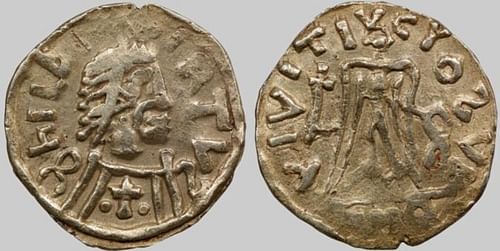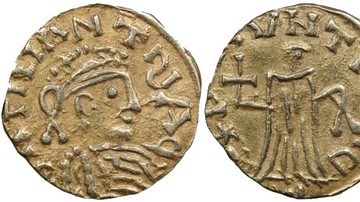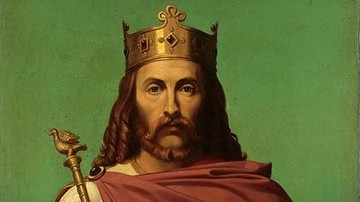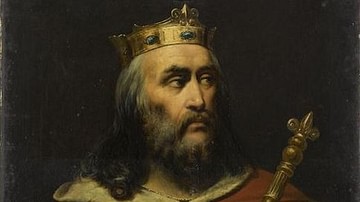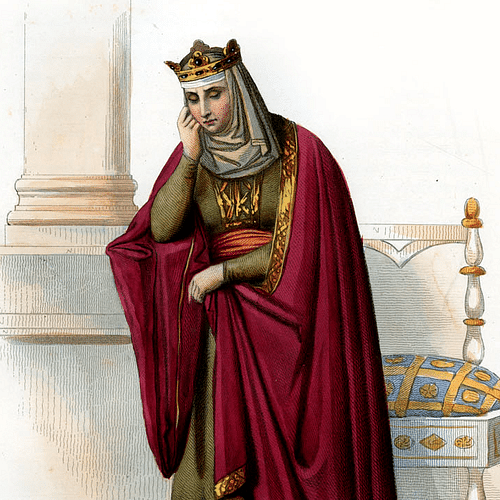
Brunhilda of Austrasia (c. 543-613) was a Visigothic princess who married into the Merovingian dynasty of the Franks, becoming the queen consort of the eastern kingdom of Austrasia. Following the brutal death of her sister due to a plot by Queen Fredegund in Neustria, Brunhilda used her position to scheme and accumulate power to outmaneuver her rival. The feud would expand into proxy wars across the Frankish realm.
Marriage to Sigebert
Brunhilda was the daughter of King Athanagild (r. 554-567) of Visigothic Spain and is described as being a "maiden beautiful in her person" and "well behaved" (IV. 27) by medieval historian Gregory of Tours. At the time, King Sigebert I of Austrasia (r. 561-575) sought her out as his wife, and the two were married in 567. Upon their marriage, Brunhilda converted from her original Arian Christian faith to Catholicism. Brunhilda and Sigebert appear to have had a happy marriage, so much so that Sigebert's half-brother Chilperic I of Neustria (r. 561-584) became jealous and conspired to have a Visigothic wife for himself.
Chilperic discarded his previous lover, a low-born woman named Fredegund, to marry Brunhilda's older sister Galswintha. However, Galswintha and Chilperic do not seem to have found the same happiness as Brunhilda and Sigebert. Galswintha was unhappy with the situation at the Neustrian court and even had Chilperic get rid of all of his concubines and mistresses. Discontent with his marriage, Chilperic reunited with Fredegund, and the two decided to take Galswintha out of the picture. Galswintha was strangled to death in her bed mysteriously while Chilperic quickly made Fredegund his new wife.
Outraged at the conspiracy against her sister, Queen Brunhilda and Queen Fredegund became fierce rivals. Even the interventions of King Guntram I of Orléans (r. 561-592) and Bishop Germain of Paris could only prevent hostilities temporarily. While Neustria and Austrasia would go to war and Frankish men fought on the battlefield, the true war was being waged in the shadows between the two queens.
By the 570s, Austrasia was winning the war against Neustria, having occupied most of the Neustrian territories. While Neustrian locals were swearing loyalty to Sigebert, Chilperic hid in Tournai. Bishop Germain of Paris wrote to Brunhilda and pleaded with her to calm her husband's rage so that he might spare Chilperic's life, but Brunhilda, on her path to revenge, ignored the bishop's letters. However, the tides turned as Fredegund sent two assassins who killed Sigebert with poisoned daggers during the Siege of Tournai.
Second Marriage
Without her husband, Brunhilda found herself working alongside a disinherited Merovingian Neustrian prince named Merovech. Merovech had been ousted by Fredegund as the Neustrian queen wanted to secure the throne for her own children, and Merovech, from Chilperic's first marriage, did not fit into this plan. Brunhilda married Merovech and the two conspired against Fredegund for a time until the Neustrians besieged the couple at the Church of St. Martin. Merovech surrendered and he was tonsured for his revolt. That is, he was sent to work at a monastery to become a priest. As a result, Merovech's marriage to Brunhilda was invalidated. Merovech would eventually escape his holy prison before an attempted coup in 578 CE failed and he had his servant kill him in disgrace.
The Power Behind the Throne
In 575, Brunhilda and Sigebert's son Childebert II (r. 575-596) ascended to the throne at age five. Brunhilda served as the young king's regent, effectively becoming the true power behind the throne of Austrasia. The discontented Austrasian nobles resisted Brunhila's rule, but Brunhilda convinced King Guntram of Orléans to support her, granting the queen the legitimacy she needed. As a competent and focused leader, Brunhilda set about repairing old roads from the time of the Romans, building churches, constructing fortresses, reorganizing the kingdom's budget, and restructuring the Austrasian army. Though she was opposed by the Austrasian nobility at every turn, Guntram's adoption of Childebert II as his heir only added to her authority's legitimacy.
By 584, Childebert had reached the age of majority, but Brunhilda still maintained some power behind the throne. Three Austrasian dukes opposed Brunhilda's influence and decided to assassinate Childebert. The plot was exposed and one of the dukes was slain. The two other dukes retreated to a fortress only to be crushed by the forces of Orléans. After the insurrection, Orléans and Austrasia signed the Pact of Andelot in which it was codified that, upon the death of King Guntram, Childebert would ascend to the throne of Orléans and unite it with Austrasia. This was another power play by Brunhilda as it effectively blocked Fredegund's puppet son King Chlothar II of Neustria (r. 584-613) from inheriting the throne of Orléans.
Guntram died in 592, and as per the Pact of Andelot, Childebert II became king of Orléans (which was gradually becoming known as Burgundy, the name of a Germanic kingdom that once stood in the region). Naturally, war broke out between Austrasia-Burgundy, puppeted by Brunhilda, and Neustria, puppeted by Fredegund. A notable battle from this war was the Battle of Droizy in 593 where Fredegund directly led Neustrian forces to victory against Brunhilda's Austrasia-Burgundian soldiers.
Regent of Austrasia-Burgundy
In 596, at the age of 26, King Childebert II died. His two sons, Theudebert II (r. 595-612) and Theuderic II (r. 595–613) succeeded him on the thrones of Austrasia and Burgundy respectively. Though Austrasia and Burgundy were two separate kingdoms once more, they were still united against Neustria and continued the war against Chlothar II and Fredegund. Likewise, Brunhilda still maintained influence over her grandsons. Even as Brunhilda's longtime rival Fredegund died, her son Chlothar II continued the war with ambitions similar to that of his ancestor and namesake Chlothar I (r. 511-558) who had united Francia half a century earlier with Neustria as the seat of that empire. Unfortunately for Fredegund's heir, Austrasian and Burgundian attacks in 600 left Chlothar ruling a rump state that administered only Beauvais, Amiens, and Rouen.

From this point, the eastern faction began to tear itself apart. Brunhilda took on a lover named Protadius and sought to award him more power by having Berthoald, the Mayor of the Palace of Burgundy, killed. The Mayor of the Palace was a special position held by those who managed the household of the king in Francia, a position with some privileges and access to power. In 604, Brunhilda had Theuderic of Burgundy send Bertoald to a villa on the Seine river. Following Brunhilda's orders, Chlothar II also sent his own mayor of the Palace named Landric to meet Bertoald. The Neustrians found the Burgundian mayor and killed him with Brunhilda able to place her lover in Berthoald's place.
Seeking to expand the power of Burgundy over Austrasia, Brunhilda and Protadius persuaded Theuderic to go to war with Theudebert, telling the Burgundian king that his brother was the son of a gardener. However, Burgundian warriors who refused to fight in the name of Brunhilda captured and killed Protadius. A heartbroken Brunhilda ordered the man who killed her lover to be arrested, tortured, and executed.
In 611, the Burgundian-Austrasian War continued as Theuderic promised to restore the Duchy of Dentelin to Chlothar's rump Neustrian state in return for his neutrality in the conflict. In 612 CE, Burgundy was victorious in the war with Austrasia with the Burgundians overthrowing Theudebert and killing both him and his son. Austrasia-Burgundy was united once again under the rule of King Theuderic II until he soon died of dysentery. Theuderic had four sons but, rather than divide the empire again, Brunhilda herself decided that only Theuderic's son Sigebert II (r. 613) would rule the Austrasian-Burgundian realm. As Brunhilda purged those who stood in her way, many of the Austrasian and Burgundian aristocrats fled to Neustria into the court of Chlothar II, supporting Neustria against Brunhilda. The Mayor of the Palace of Austrasia, Warnachar, felt concerned about the young King Sigebert and that he would become, like the Austrasian kings before him, just another puppet for his great-grandmother. Warnachar as well as other mayors like Rado, Pepin of Landen, and Arnulf of Metz fled to Neustria to join their side against Austrasia.
As war broke out between Neustria and Austrasia-Burgundy, Brunhilda led the battle against Chlothar II, the son of her old enemy, in the Battle of Aisne. More Austrasian and Burgundian dukes betrayed their queen, defecting to Neustria during the battle. This turned the tide so that Brunhilda and Sigebert II had to flee the battlefield. The monarchs fled to the city of Orbe in what is now Switzerland to seek Germanic allies, but Neustrian forces captured them. Brunhilda's sons, including King Sigebert II, were all killed with the exception of one Prince Merovech who, like the Merovech before him, managed to escape a premature death at the cost of living his life in a medieval monastery. Chlothar assumed leadership over Austrasia-Burgundy and, after 52 years, the Kingdom of Francia was all under the crown of one ruler again, with Chlothar II being the third king of a united Francia.
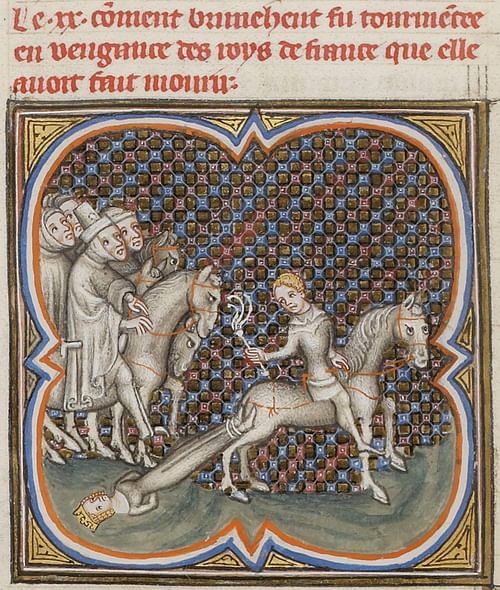
Chlothar accused Brunhilda of the death of ten Frankish royal family members and churchmen. The Frankish soldiers declared that death would be most fitting for the unpopular queen. As the method of execution, Brunhilda's limbs were tied to wild horses who ran off in different directions. Her remains were burned so that no trace of her was left.
Remembering the Queen
Queen Brunhilda's legacy is mixed. She is praised for her morality, virtue, and intelligence while simultaneously criticized as being power-hungry and driven to a fault. While her Visigothic origins served as a sticking point with the Germanic population of Francia, she simultaneously had influence in Austrasia even after her death as King Chlothar II had to vilify her legacy and place Francia's problems on her memory in an effort to unite the kingdom and antagonize the pro-Brunhilda forces that resisted his rule. Nevertheless, Brunhilda goes down in history as a queen of great power and influence despite living in a time when women were not allowed to sit upon the Frankish throne.

